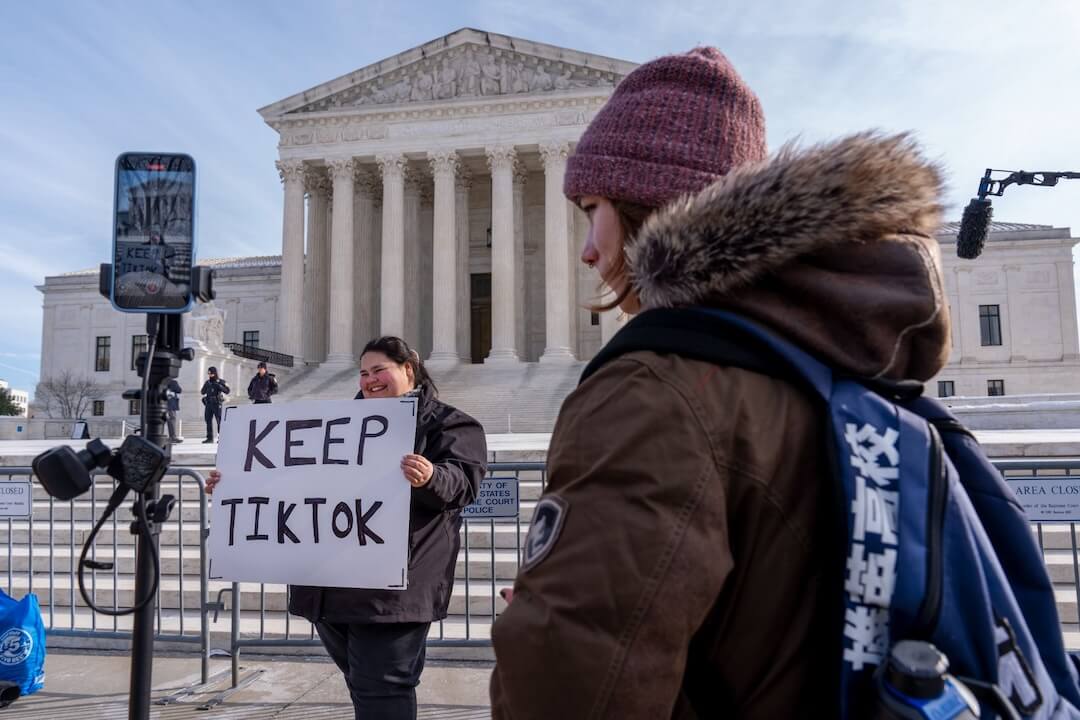 Covering COVID-19 is a daily Poynter briefing of story ideas about the coronavirus and other timely topics for journalists, written by senior faculty Al Tompkins. Sign up here to have it delivered to your inbox every weekday morning.
Covering COVID-19 is a daily Poynter briefing of story ideas about the coronavirus and other timely topics for journalists, written by senior faculty Al Tompkins. Sign up here to have it delivered to your inbox every weekday morning.
It is more or less a formality, but the Biden administration says it is withdrawing its attempt to have the Occupational Safety and Health Administration enforce a vaccine mandate or testing requirement for businesses with 100 or more employees. The Supreme Court overturned the OSHA requirement on Jan. 13.
The court left open the door for a refined mandate that does not treat every job as though it presents the same risk of COVID-19 exposure, and OSHA’s newest statement on its website leaves open that possibility.
For example, the justices mentioned that a person who works close to others in a meatpacking plant might have higher exposure than a lifeguard or somebody else who works outside and alone. The justices also allowed a mandate for health care workers whose employers get federal funds.
Despite Supreme Court ruling, few employers with vaccine mandates drop them
A third of U.S. employers polled by Gartner Inc. said that even though the Supreme Court overturned the Biden administration’s vaccine or test mandate, they will keep their vaccine requirements in place. Only 3% of employers said the court’s decision led them to drop the requirements. More than a fourth of employers said they still have not decided whether to mandate a vaccine.
Here is a sizeable list of big employers with vaccine/testing mandates.
The patchwork of local vaccinate-or-test rules
The courts have consistently ruled that local governments have a good bit more authority to impose vaccination mandates than the federal government. That leaves us with a patchwork of rules. Here is a summary of where things stand from nonprofit LeadingAge:
- So far, there are 25 states that require vaccination for employees of various categories; six are now requiring boosters or “up to date” status of vaccines.
- Of those, twenty-one specify requirements for healthcare workers, and the majority of those states require vaccination or regular testing of unvaccinated employees.
- Six states have taken a “vaccinate or terminate” approach, only permitting healthcare workers to be unvaccinated if they have a valid religion or medical exemption as defined for by the EEOC.
- Thirteen states have passed laws that ban employers from mandating vaccines for workers; three more states are expected to enact such bans in the near future.
FDA ends emergency use authorization for two monoclonal antibody treatments

A sign advises the public that a site administering monoclonal antibody treatments for COVID-19 at Tropical Park has been closed in compliance with federal regulations, Tuesday, Jan. 25, 2022, in Miami. (AP Photo/Rebecca Blackwell)
The Food and Drug Administration revoked most emergency use authorizations for monoclonal antibodies produced by Regeneron and Eli Lilly. Both companies had said that their medicines were not effective against the omicron variant of the virus, but some hospitals and physicians were prescribing the expensive treatments anyway. Florida Gov. Ron DeSantis was an especially vigorous supporter of the treatments despite the companies’ warnings that the treatment was not effective.
In its new advisory to health care providers, the FDA said Regeneron is 1,000 times less effective against omicron than against previous strains of the virus. Despite that, Florida officials said they had at least 2,000 appointments for people scheduled to get the treatment.
Providers in Florida, Michigan, Indiana, Missouri, Louisiana, California, Oklahoma, Kansas, Georgia, Ohio, New York and Mississippi used the most courses of the Regeneron and Lilly treatments from Jan. 5 through Jan. 18, according to an analysis by Kaiser Health News.
The FDA still authorizes the Regeneron and Lilly drugs if a patient is found to have been infected with variants of the virus other than omicron. Dr. Patrizia Cavazzoni, director of the FDA’s Center for Drug Evaluation and Research, said in an online statement:
Because data show these treatments are highly unlikely to be active against the omicron variant, which is circulating at a very high frequency throughout the United States, these treatments are not authorized for use in any U.S. states, territories, and jurisdictions at this time. In the future, if patients in certain geographic regions are likely to be infected or exposed to a variant that is susceptible to these treatments, then use of these treatments may be authorized in these regions.
Monoclonal antibodies are laboratory-made proteins that mimic the immune system’s ability to fight off harmful pathogens such as viruses, like SARS-CoV-2. And like other infectious organisms, SARS-CoV-2 can mutate over time, resulting in certain treatments not working against certain variants such as omicron. This is the case with these two treatments for which we’re making changes today.
The antibody treatment now most recommended is sotrovimab, from GlaxoSmithKline and Vir Biotechnology. But supplies are limited. The FDA mentions other viable treatments:
Importantly, there are several other therapies — Paxlovid, sotrovimab, Veklury (remdesivir), and molnupiravir — that are expected to work against the omicron variant, and that are authorized or approved to treat patients with mild-to-moderate COVID-19 who are at high risk for progression to severe disease, including hospitalization or death. Healthcare providers should consult the NIH panel’s COVID-19 treatment guidelines and assess whether these treatments are right for their patients.
The FDA said that none of the treatments work as well as vaccinations at preventing severe illnesses from COVID-19.
What to watch when the Fed meets today
One of the ingredients baked into the stock market’s wild swings this week is speculation about what the Federal Reserve Board will do and say today at a 2 p.m. news conference. The Fed is expected to emerge from its meeting with an announcement that it will take action that will raise interest rates as soon as March. Eventually, those rates show up in the loan rates you pay. The rate hikes are one way that the Fed can do its job of controlling inflation, but any move sends waves through investment tools like stocks.
When the Fed raises rates, it makes it more expensive to borrow, and that slows the economy. Inflation happens when the economy is red hot and demand exceeds supply, especially in the housing market. Low interest rates drive home buying, which drives up prices. Housing costs are a key component of the national inflation rate, along with the price of both new and used automobiles.
And that is why the stock market is reacting. A slower economy that cools inflation might also cool industrial production.
Want to learn more about how the Fed influences interest rates and how that affects the economy and your money? Go here to start. And here is a one-minute video that explains the concept of the “fed rate.”
Despite COVID-19, people are packing bars, restaurants and gyms

In this July 7, 2021, file photo, patrons enjoy tropical cocktails in the tiny interior of the Tiki-Ti bar as it reopens on Sunset Boulevard in Los Angeles. (AP Photo/Damian Dovarganes, File)
New data shows people are moving on from COVID-19. Bloomberg reports:
Recent numbers show the desire to break free: The people-connecting platform Meetup reports that RSVPs were up 22 percent nationally in the first week of this month compared with a year ago — 20 percent even in careful New York City. Restaurant traffic suggests that dining out lost ground when omicron hit, but it has begun to rebound in the past week. In San Francisco, mobility data show that even with a recent omicron-period drop, residents are spending less time hunkered down.
In New York, it’s easy to assume from somnolent Manhattan that the city is still largely shut down. Mobility data from the other four boroughs show that while Financial District office towers may be desolate, people are out and about in their home neighborhoods.
Indeed, data from the past week show that San Franciscans are getting out more than they did a year ago. They’re still spending more time at home than before the pandemic, but 5 percentage points less than last January, according to Google Community Mobility Reports. That’s despite the fact that the virus is about seven times more prevalent.
In Dearborn, Michigan, customers at Famous Hamburger increased last month despite surging cases, and they’ve remained plentiful, said owner Mohammed Hider, who has gone back to normal activity himself.
You can see from these Google Mobility Reports that there seems to be a rebound, but we are still off from normal in important ways:
Let’s dive into some state-level Google Mobility Reports. You can get the data for your state here. Florida’s data, for example, shows people have largely returned to near baseline activity, while other states, even highly vaccinated states, are still more cautious about traveling and socializing.

(Google Mobility Report, Jan. 21, 2022)
Why can’t we get a vaccine that anticipates COVID-19 variants?
Smart people are asking why drug companies can’t anticipate the next variant of COVID-19 with at least the accuracy that they anticipate the next variant of the seasonal flu. The Mercury News took on the question:
“With the flu, we can predict what we’ll see in the winter, but with COVID, it’s shape-shifting, you’re playing Whac-A-Mole because who knows what’s coming next,” said Dr. Peter Chin-Hong, a medical professor and infectious disease specialist at UC San Francisco. “That’s why it’s so frustrating.”
As the reporting points out, every new incarnation of a vaccine has to go through extensive field trials, a review and approval, and then to production and distribution. It is a long and expensive process with no guarantee of positive results. For example, fourth-dose field trials in Israel proved disappointing.
We’ll be back tomorrow with a new edition of Covering COVID-19. Are you subscribed? Sign up here to get it delivered right to your inbox.











